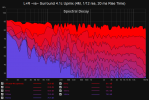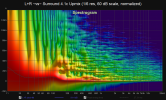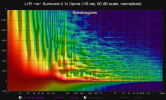- Thread Starter
- #41
Yes, if we normalize later sound to the first arrival, we see how the speaker-room changes the spectral distribution of the reflected energy.
If the speaker has smooth and reasonably flat off-axis response, and the room is not overly strange, the later decay lines will be more equal to the first. As we move further out in time, the lines will tend to look like the power response of the speaker.
Let us say we have a speaker with wider radiation around 5KHz, and collapsing highs above 8KHz. Then we will see that the later decay lines will have a boost around 5K, and then drop off above 8K.
If we mis-treated the room with too much high frequency absorption, we will see that the higher frequencies drops off in the later decay lines.
This will hold until we get down to quite low frequencies. In the bass-range, the room will be dominant, regardless of speaker radiation pattern.
Really appreaciate this, I never thought I will one day understand the basics with decay graphs. I can imagine there is a lot that comes with experience such as knowing what a good sounding room really looks like, but for now I am delighted to get this down pat but just to confirm, when you say a boost around 5k do you mean an elevation in the SPL(repsonse curve)? As in the the first line elevated or all the decay lines elevated? Or the decay lines closer to each other?(I think decay lines closer to each other means room modes)
And when you say "normalize later sound to the first arrival" are you figuratively speaking or its something I have to do with REW to "normalize" it? Maybe you just mean comparing them yes?
And yes, I just saw my room has the decay lines drop off from around 12k and is fairly absorbed but I can now compare this to the RT60 graph and get a better undestanding, like you said each graph complements each other and in isolation don't say too much. And I am guessing its no coincidence that my horn speakers have the subsequent decay lines more similar to the first compared to my wide dispersion speakers.
Lastly, what does it mean if the high frequencies say around 7k to 12k are bunched up with decay lines closer together? I thought this was a low frequency phenomenan? They get closer together towards the 7k with the subsequent later time intervals such as 140ms.




